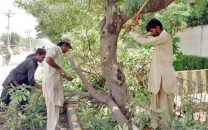Thal reaping dividend of afforestation
Local landowners contribute to plantation drive expenditure

Farmers in Khushab's Thal area have started benefitting from from the results of the government’s afforestation efforts over the past years.
Local forest expert Ahmed Hayat told The Express Tribune that about 45 per cent of the total area of Khushab district is covered by desert Thal, where gram, guwar and other crops dependent on rain are cultivated traditionally.
Till 15 years ago, there were forests in less than 1% of Thal area. More than half a million people living in the region were poor and lacked access to financial, health and education facilities due to rapidly growing population and climate change. At the same time, establishment of industries resulted in an increase in pollution.
The issues prompted a push for expanding forests across the world, including Pakistan, to improve the environment and mitigate the adverse impact of climate change.
Thal had the potential to offer substantial economic and environmental benefits of forestation because of a good groundwater quality and level.
Divisional Forest Officer Naseem Iqbal said the Punjab Forest Department had taken steps since 2005 to help people in the Thal area to grow forests on their own land. Financial assistance and training were provided to local people for the purpose.
The Punjab and federal governments, UNDP, ADB and other financial institutions and agencies provided financial assistance of 70 to 80 per cent of the expenses in this regard.
The local landowners contributed the remaining expenditure and labour for the afforestation.
When the financial support and water resources were provided, the local people actively participated in the programme.
In 2015, a team from the Khushab Forest Department and Agricultural University Faisalabad conducted research on the afforestation in Thal, revealing that forests found over about 20% of the area had caused a reduction of 6.6 mega tonnes of carbon dioxide and pollutants from the environment. The team reported that the scope of forestry in Thal area was 55%.
A local resident, Tanvir Tiwana, said local landowners were earning large amounts per acre by growing forests, which was helping them access better education and health facilities.
Social activist Mohammad Asif said the society as a whole had prospered in the area as a result of the initiative. However, he said it was important that the government should adopt a strategy to protect the trees instead of cutting down and selling them to generate revenue. This way the benefits of the forests would be reaped by the future generations.
Chief Conservator Shahid Zaman Awan said work for promoting forests in the area had grown rapidly since 2015. More than 30% of the total area of Nurpur, Quaidabad and Khushab Tehsils comprises of forests that are are spreading steadily.
The developments have attracted the timber industry to the region. Wood factories have been set up in Adhi Kot and Rangpur. Noorpur has become the hub for the supply of wood used in the factories, where trading of millions of rupees is being done daily for producing goofs for supy across the country as well as Afghanistan.
The standard of living of the people of the region has improved along with employment opportunities.
Punjab Forests Secretary Shahid Zaman Khan said in reply to a question that all countries should have a 25% forest cover of its area, but the ratio in Pakistan was 5.2%.
He said it was an accomplishment of the officials concerned that the percentage of forest cover in Khushab district was 30.
Published in The Express Tribune, October 30th, 2021.






1675249047-0/image-(18)1675249047-0-208x130.webp)












COMMENTS
Comments are moderated and generally will be posted if they are on-topic and not abusive.
For more information, please see our Comments FAQ